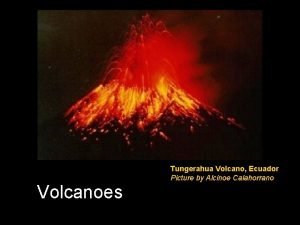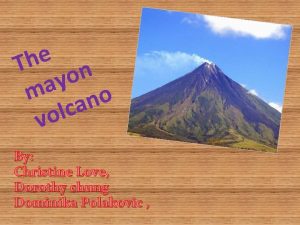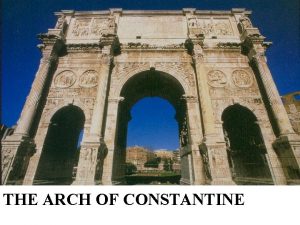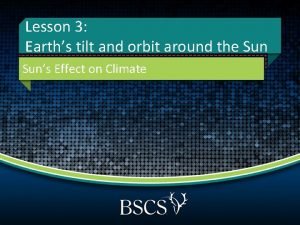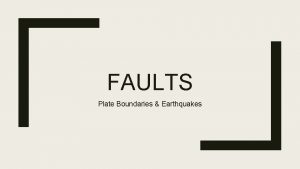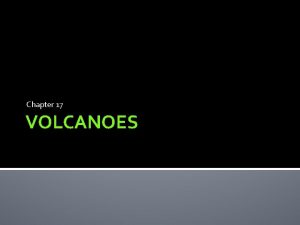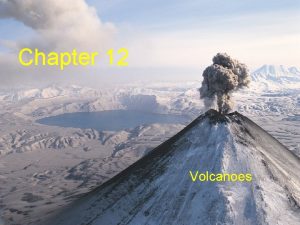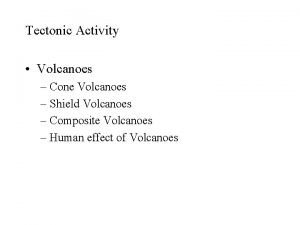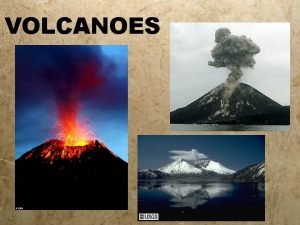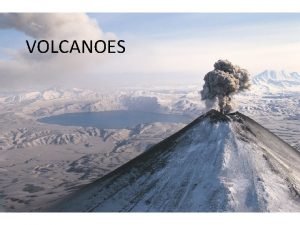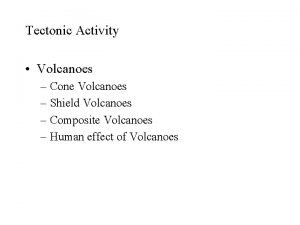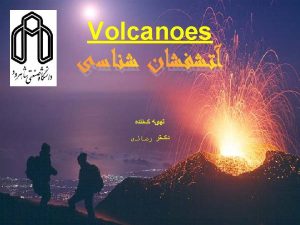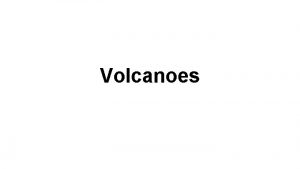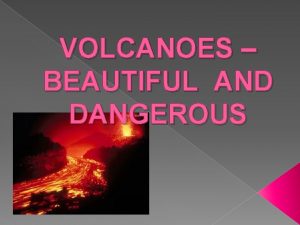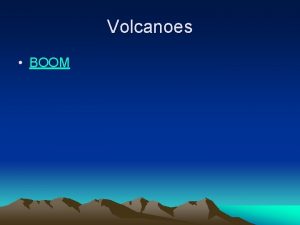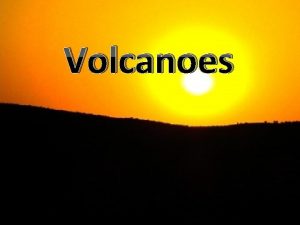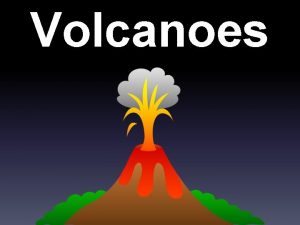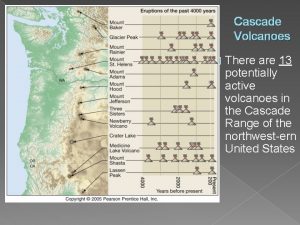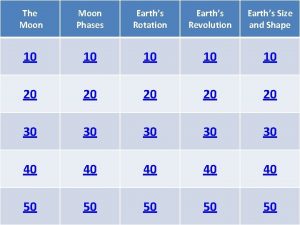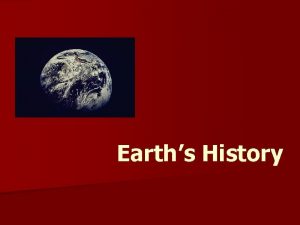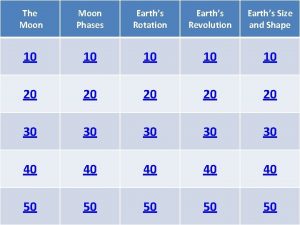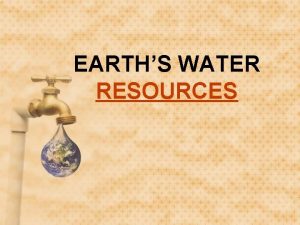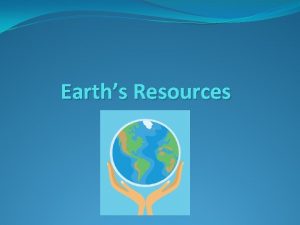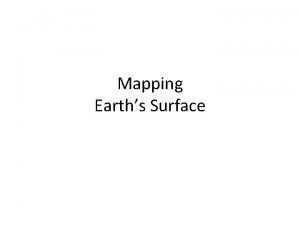Volcanoes Chapter 7 Earths Active Volcanoes Chapter 7






























- Slides: 30

Volcanoes Chapter 7

Earth’s Active Volcanoes

Chapter 7 - Volcanoes • A volcano is a weak spot in the crust where melted material comes to the surface. • Most volcanoes happen at plate boundaries.


Chapter 7 - Volcanoes • Some volcanoes form over hot spots, which are places where material rises from deep in the mantle. • Hot spot volcanoes on the ocean floor can become islands. – Ex. Hawaiian Islands • Some hot spots are under the middle of plates. – Ex. Hot spot under Yellowstone National Park

Chapter 7 - Volcanoes • Properties of magma: • Viscosity is how well a liquid flows. • Viscosity of magma depends on its silica content and temperature. • High silica, high viscosity lava flows slowly. • Low silica, low viscosity lava flows quickly. • Hotter magma has lower viscosity than cooler magma

Chapter 7 - Volcanoes • Very hot magma produces lava called pahoehoe. It has low viscosity, flows quickly, hardens into a rippled surface. • Cooler magma produces lava called aa. It has high viscosity, flows slowly, hardens into rough chunks.

Chapter 7 - Volcanoes • When a volcano erupts, the force of the expanding gases pushes magma from the magma chamber through the pipe until it flows or explodes out of the vent.

Chapter 7 - Volcanoes

Chapter 7 - Volcanoes • A volcano erupts quietly if the magma is low in silica and flows easily. Lava may flow for many kilometers before it starts to harden. – Ex. Mount Kilauea

Chapter 7 - Volcanoes • A volcano erupts explosively if the magma is high in silica and does not flow easily. The lava cools quickly. Hard lava pieces range in size from ashes and cinders to very large chunks called bombs. – Ex. Mount St. Helens

Chapter 7 - Volcanoes • A pyroclastic flow occurs when an explosive eruption hurls out a mixture of hot gases, ash, cinders, and bombs.

Chapter 7 - Volcanoes • Geologists often use the terms active, dormant, or extinct to describe a volcano’s stage of activity. – A volcano is active when it is erupting or showing signs that it will erupt soon. • Ex. Mt. Etna (Italy)

Chapter 7 - Volcanoes • A volcano is dormant when it is no longer erupting but may erupt again in the future. – Ex. Mt. Hood

Chapter 7 - Volcanoes • A volcano is extinct when it is no longer likely to erupt, even in the future. – Ex. Mt. Kilimanjaro (Tanzania, Africa)

Chapter 7 - Volcanoes • Volcanic eruptions create landforms made of lava, ash, and other materials. • These landforms include shield volcanoes, cinder cone volcanoes, composite volcanoes, and lava plateaus.

Chapter 7 - Volcanoes • A shield volcano is a gently sloping mountain. • Forms when a volcano erupts quietly. • Thin layers of lava build up slowly over a large area around the vent. – Ex. Mauna Loa (Hawaii)

Chapter 7 - Volcanoes • A cinder cone is a steep, cone-shaped hill or small mountain. • Forms when a volcano erupts explosively. • Ashes, cinders, and bombs pile up around the vent. • Ex. Paricutin (Mexico)

Chapter 7 - Volcanoes • A composite volcano is a tall, cone-shaped mountain. • Forms when a volcano erupts quietly and then explosively, over and over again. • Layers of lava are followed by layers of ash, cinders, and bombs. – Ex. Mt. Shasta (California)

Chapter 7 - Volcanoes • A caldera is formed when a magma chamber empties and collapses. • This leaves a huge hole. • A caldera may fill with water to form a lake. – Ex. Crater Lake [Wizard Island is a cinder cone]

How a caldera forms:

Chapter 7 - Volcanoes • Features formed by magma include volcanic necks, dikes, and sills, as well as batholiths and dome mountains.

Chapter 7 - Volcanoes • A volcanic neck forms when magma hardens in the pipe of a volcano. • Softer rock around the pipe wears away, leaving just the neck standing. A volcanic neck looks like a giant tooth stuck in the ground. – Ex. Devils Tower, Wyoming

Chapter 7 - Volcanoes • A dike forms when magma hardens across rock layers. • A dike is a vertical, or up-and-down, layer of hardened magma. – Ex. Dike on Santorini (Greece)

Chapter 7 - Volcanoes • A sill forms when magma hardens between rock layers. • A sill is a horizontal, or sideways, layer of hardened magma.

Chapter 7 - Volcanoes • A batholith forms when a large amount of magma hardens inside the crust. • A batholith is a large rock mass. • It may become part of a mountain range. – Ex. Half Dome (Yosemite, California)

Chapter 7 - Volcanoes • Hot springs and geysers are types of geothermal activity that are often found in areas of present or past volcanic activity. • Magma below the surface can heat underground water.

Chapter 7 - Volcanoes • The heating of underground water by magma is called geothermal activity. • http: //www. classzone. com/books/earth_sci ence/terc/content/visualizations/es 1403 page 01. cfm? chapter_no=visualizatio n

Chapter 7 - Volcanoes • A hot spring forms when water heated by magma rises to the surface and collects in a natural pool.

Chapter 7 - Volcanoes • A geyser forms when hot water and steam are trapped underground in a narrow crack. • Pressure builds up until the hot water and steam erupt from the ground.
 Active volcanoes map
Active volcanoes map Interesting facts about mt mayon
Interesting facts about mt mayon Chapter 8 earthquakes and volcanoes
Chapter 8 earthquakes and volcanoes Earths layers foldable
Earths layers foldable Earths roation
Earths roation Whats a natural satellite
Whats a natural satellite Home sweet biome crossword
Home sweet biome crossword Most common elements in the earth's crust
Most common elements in the earth's crust How thick is the earths crust
How thick is the earths crust Whats earths moon called
Whats earths moon called What is earths thickest layer
What is earths thickest layer Earths early atmosphere contained
Earths early atmosphere contained Lithosphere is made up of
Lithosphere is made up of Earths major crustal plates
Earths major crustal plates Earths orbit seasons
Earths orbit seasons Brown earths
Brown earths Study of earth's physical features
Study of earth's physical features Earth's honey fertilizer
Earth's honey fertilizer Whats the name of earths moon
Whats the name of earths moon Earths mantle
Earths mantle Earths crust
Earths crust Earths interior
Earths interior What does the earths tilt cause
What does the earths tilt cause Earth's atmosphere description
Earth's atmosphere description What is the true shape of earth
What is the true shape of earth Arch of constantine reliefs
Arch of constantine reliefs What does earths tilt do
What does earths tilt do Earths boundaries
Earths boundaries Earths 4 spheres
Earths 4 spheres Boolean operators
Boolean operators Active transport
Active transport
